#wild animal hunting in africa
Text
Leopard Vs Ostrich - Battle Of Speed - Wild Animal Hunting New
Top High Graphics Games Download
Click Here For Latest Free Games - https://za.uy/yF10

#wild animal hunting#wild animal hunting videos#wild animal hunting in africa#wild animal hunting in nepal#amazing wild animal hunting#african tribe hunting wild animal#wild life hunting full hd video#wild animals hunting in forest#wild animals hunting in telugu#wild animal hunting jamaica#wild animal hunting japan#wild animals hunting tamil#wild animal hunting usa#wild animal hunting us#leopard vs ostrich#leopard vs ostrich attack#leopard vs ostrich hunting#leopard vs ostrich india#leopard vs ostrich in the wild#jaguar vs ostrich#funny_dogs_video_2022#fashion#funny_animals_video#funny_cats_video_2022#beauty#bestfunnyanimalvideos2022#health & fitness#home & lifestyle#makeup#bestfunnyanimalsvideointheworld
0 notes
Text

African Wild Dog aka Cape Hunting Dog (Lycaon pictus) in hot pursuit of an impala, family Canidae, Kruger National Park, South Africa.
ENDANGERED.
photograph by Chris Jolley
@cdj_photo
180 notes
·
View notes
Text

#wild#wildlife#africa#jackal#travel#animal#namibia#etosha#etosha national park#kalahari#animals#animals of africa#wildlife photography#travel photography#animal photography#safari#savannah#namibian#black backed jackal#scavenger hunt#scavenger#african animals#travel blog#travels#african
26 notes
·
View notes
Video
FROM : lalulutres
#lalulutres#video#deers#wild dogs#rivers#huntings#wild animals#wildlife#animals & wild animals#africa
40 notes
·
View notes
Text
There was this post a while ago where somebody was saying that Cheetahs aren't well suited to Africa and would do well in Midwestern North America, and it reminded me of Paul S. Martin, the guy I'm always pissed off about.
He had some good ideas, but he is most importantly responsible for the overkill hypothesis (idea that humans caused the end-Pleistocene extinctions and that climate was minimally a factor) which led to the idea of Pleistocene rewilding.
...Basically this guy thought we should introduce lions, cheetahs, camels, and other animals to North America to "rewild" the landscape to what it was like pre-human habitation, and was a major advocate for re-creating mammoths.
Why am I pissed off about him? Well he denied that there were humans in North America prior to the Clovis culture, which it's pretty well established now that there were pre-Clovis inhabitants, and in general promoted the idea that the earliest inhabitants of North America exterminated the ecosystem through destructive and greedy practices...
...which has become "common knowledge" and used as evidence for anyone who wants to argue that Native Americans are "Not So Innocent, Actually" and the mass slaughter and ecosystem devastation caused by colonialism was just what humans naturally do when encountering a new environment, instead of a genocidal campaign to destroy pre-existing ways of life and brutally exploit the resources of the land.
It basically gives the impression that the exploitative and destructive relationship to land is "human nature" and normal, which erases every culture that defies this characterization, and also erases the way indigenous people are important to ecosystems, and promotes the idea of "empty" human-less ecosystems as the natural "wild" state.
And also Martin viewed the Americas' fauna as essentially impoverished, broken and incomplete, compared with Africa which has much more species of large mammals, which is glossing over the uniqueness of North American ecosystems and the uniqueness of each species, such as how important keystone species like bison and wolves are.
It's also ignoring the taxa and biomes that ARE extraordinarily diverse in North America, for example the Appalachian Mountains are one of the most biodiverse temperate forests on Earth, the Southeastern United States has the Earth's most biodiverse freshwater ecosystems, and both of these areas are also a major global hotspot for amphibian biodiversity and lichen biodiversity. Large mammals aren't automatically the most important. With South America, well...the Amazon Rainforest, the Brazilian Cerrado and the Pantanal wetlands are basically THE biodiversity hotspot of EVERYTHING excepting large mammals.
It's not HIM I have a problem with per se. It's the way his ideas have become so widely distributed in pop culture and given people a muddled and warped idea of ecology.
If people think North America was essentially a broken ecosystem missing tons of key animals 500 years ago, they won't recognize how harmful colonization was to the ecosystem or the importance of fixing the harm. Who cares if bison are a keystone species, North America won't be "fixed" until we bring back camels and cheetahs...right?
And by the way, there never were "cheetahs" in North America, Miracinonyx was a different genus and was more similar to cougars than cheetahs, and didn't have the hunting strategy of cheetahs, so putting African cheetahs in North America wouldn't "rewild" anything.
Also people think its a good idea to bring back mammoths, which is...no. First of all, it wouldn't be "bringing back mammoths," it would be genetically engineering extant elephants to express some mammoth genes that code for key traits, and second of all, the ecosystem that contained them doesn't exist anymore, and ultimately it would be really cruel to do this with an intelligent, social animal. The technology that would be used for this is much better used to "bring back" genetic diversity that has been lost from extant critically endangered species.
I think mustangs should get to stay in North America, they're already here and they are very culturally important to indigenous groups. And I think it's pretty rad that Scimitar-horned Oryx were brought back in their native habitat only because there was a population of them in Texas. But we desperately, DESPERATELY need to re-wild bison, wolves, elk, and cougars across most of their former range before we can think about introducing camels.
2K notes
·
View notes
Photo

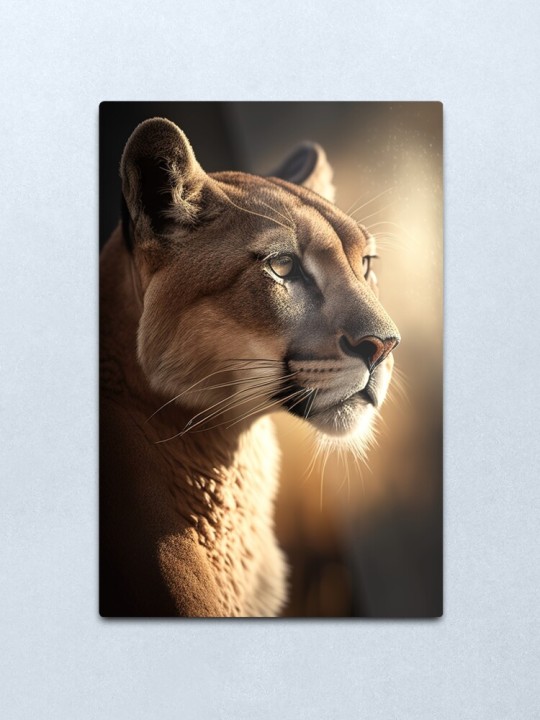
(via Portrait of a female lion Metal Print by Remco Kouw)
#findyourthing#redbubble#lion wild portrait female majestic dramatic gaze animal wildlife bigcat nature Africa hunting roar strength pride kingofthejungle feline fur
0 notes
Text
Animal of the Day!
Northern Bald Ibis (Geronticus eremita)

(Photo by Richard Bartz)
Conservation Status- Endangered
Habitat- Morocco; Turkey
Size (Weight/Length)- 1.3 kg; 80 cm
Diet- Insects; Reptiles; Snails; Scorpions; Small mammals
Cool Facts- The Northern bald ibis could once be found across Europe, the Middle East, and Africa but hunting and persecution has driven this bird to near extinction. With less than 700 birds in the wild and 2,000 in captive breeding programs, efforts to reintroduce these non-wading ibis are intensive. The Northern bald ibis live in small groups on cliff ledges and arid steppes as they search for insects and small mammals. These ibis have a close connection with Mediterranean culture. In Ancient Egypt, these birds were sacred and considered the embodiment of Thoth. Greek Stymphalian birds were possibly based on Northern bald ibis. In Turkey, these ibis are symbols of fertility and were thought to be the first animal released from Noah’s Ark.
Rating- 13/10 (A conservation success story in the making.)
#animal of the day#animals#birds#ibis#saturday#september 16#northern bald ibis#biology#science#conservation#the more you know#mythology#egyptian mythology#greek mythology
326 notes
·
View notes
Note
what does your username mean?
Cat ghost.
As child. Would go to library, to look at books about creatures, with a pen and notepad. Or sit before a television watching "nature" documentary stuff, with a pen and notepad. Was fixated on habitats. The context. Did not like to isolate an individual creature from the wider ecological community. This led to interest in geography, distribution range maps. Was aware that, in popular perception, some creatures were strongly associated with a particular place. "Lion is an African animal. Tiger is an Asian animal." Allegedly. And other stereotypes (many of them, I would later come to learn, due to chauvinism, exoticism, Orientalism, colonialism, etc.). Came across a kind of large textbook on wild cats. Saw the historical distribution maps. Only a few centuries ago, tigers were in Anatolia, the Caucasus, near the shores of the Black Sea. Was intrigued. From the middle of the twentieth century onward, the lion and cheetah were so closely associated with Africa, where like over 99% of their range was located. And yet. There remains a small remnant population of nearly-extinct Asiatic lions far away within India''s borders. And there remains a small remnant population of nearly-extinct Asiatic cheetahs within Iran's borders. And all that space, in between, where both cats were now extinct. Only 100 years ago, tiger, lion, leopard, and cheetah all lived generally near each other, still, in eastern Anatolia, near Mesopotamia, etc. And now, only a few dozen wild native cheetah remain on the entire continent of Asia.
"Cheetah". The word for this cat is from South Asia. Through Hindi, from Sanskrit.
"What happened?" I read on. Cheetahs were present within the national borders of what is now India, along with tigers, lions, and leopards. By the 1500s, there was a tradition in South Asia, where some in the Mughal aristocracy enjoyed using cheetahs as companions in sport hunting. The cats would be captured in the wild, and then trained, and then brought along on royal hunts. The cat was the star athlete, goaded into chasing down prey, for the entertainment of the hunting party. There are elaborate paintings, commissioned by Mughal courts and some now displayed in collections of European museums, depicting trained cheetah hunts. It has since been popularly said that Akbar was particularly fond of cheetahs. (Akbar the Great was the "emperor" who is credited often for consolidating Mughal state power across India, solidifying regional power by building administrative systems/structures in India ["forging an empire out of fiefdoms"] that would later eventually be manipulated and overtaken by the British Empire. According to some tellings of the historical narrative.)
Accurate or not, it was said that at any one time, Akbar possessed one thousand cheetahs. A vast royal menagerie. The names of several of the most celebrated cheetahs are still known. In some stories, when he was still young, Akbar was presented with a gift. His very first cheetah: Fatehbaz.
This disturbed me. A child, reading this book, I was upset by the idea of such a vast menagerie of wild animals. Large wild animals, with great need for food, space, enrichment. I was upset by the exploitation of captive wild animals as displays of aristocratic wealth, not just in the Mughal state(s), but also those menageires and exhibitions elsewhere, both earlier and later in time: the royal hunts of Assyrian kings, the Roman arenas, Charlemagne's elephants, European circuses.
So, as a child, I imagined that Fatehbaz resisted the captivity. Like in a daydream, a fantasy. I imagined a royal menagerie breaking free from restraint. I imagined elephants and rhinos and tigers and lions and leopards and jackals and crocodiles. I imagined the beasts attacking an emperor's court. But there are now less than one hundred cheetahs which survive in the wild in Asia. And when Mughal statecraft gave way to European statecraft, when Britain moved into South Asia, the bounty hunting specifically targeted big cats. And, meanwhile, the cats were confronted indirectly with habitat destruction, commodity crop monocultures, industrial-scale resource extraction. So I came to imagine the ghosts of cats. The ghost of a cheetah like Fatehbaz on the Indus plain. The ghost of a jaguar in the Sonoran desert. The ghost of a lion on the Mediterranean coast. The ghost of a tiger on the Amu Darya shore beyond Bukhara, where even the Aral Sea itself has vanished.
123 notes
·
View notes
Text

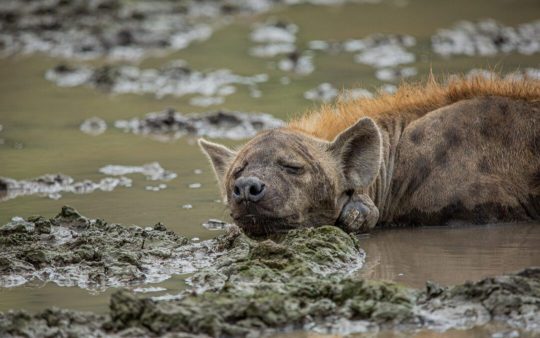

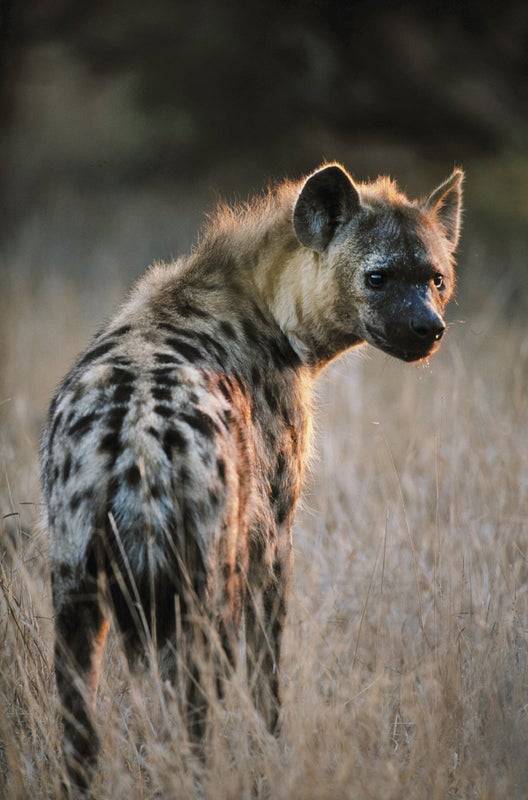
Say Hi to the Spotted Hyena
The spotted hyena is also known, perhaps most famously, as the laughing hyena (Crocuta crocuta). This species once ranged throughout Eurasia, but following the end of the Ice Age was restricted to sub-Saharan Africa. Today they can be found in many types of dry, open habitat, including savannah, semi-desert, and mountain forests. At times, the spotted hyena may also enter urban areas in search of food.
Unlike other hyenas, Crocuta crotuta is a predator, not a scavenger. They most commonly prey on wildebeast, but they may also hunt zebra, gazelles, Cape buffalo, and warthog. In addition, desperate times may cause packs to hunt on more dangerous prey such as young hippopotamus, giraffe, and rhinoceros. Spotted hyenas have incredible endurance, reaching speeds of 60 km/hr (37 mph); a single chase can last over 24 km (14 miles). When live prey is scarce, the laughing hyena can also turn to carrion, as well as snakes and ostrich eggs. In turn, this species may be killed by lions, though this may be motivated more by competition than prey drive.
Spotted hyena females are typically larger than males, weighing 44.5–67.6 kg (98–149 lb) to the males' 40.5–69.2 kg (89.3–153 lb). The height range for both sexes lies between 70–91.5 cm (27.6–36.0 in). In addition, female laughing hyena are somewhat famous for their masculinated genetalia; the clitoris is enlarged, resembling a penis, and is accompanied by sacs filled with fibrous tissue that resemble a scrotum. As the name implies, the coat is light brown with darker spots over most of the body. Because the species has such a wide diet, it has was is considered to be the strongest in relation to size of any mammal. The bite force is stronger than that of a brown bear, and can exert a force of 4,500 newtons-- enough to crush bone.
The laughing hyena is a highly social animal, and individuals live in communities up to 80 strong; size largely depends on prey availability and whether or not the group migrates. A clan territory can be anywhere from 40 km (24 mi) to 1000 (621mi) squared. Females dominate the males, and a pack is usually led by a matriarch. Hierarchies are strictly enforced, and positions are primarily inherited through birth and transferred through death. In addition, one's rank is maintained and recognized through social alliances and their contributions to the clan rather than size or dominance displays. The entirety of the clan comes together most often when defending a territory, gathering at the communal den, or at a kill; however, these kills are more commonly produced from smaller offshoots of the clan.
Crocuta crotuta can breed year-round, though mating is at its peak during the wet season from April to June. Members of both sexes pair indiscriminately with multiple mates, both within their clan and without. To offer himself, the male performs a mating ritual in which he lowers himself to the ground before the female, and retreats if any aggression is shown. Once impregnated, the female carries for about 110 days before giving birth to two cubs-- three is fairly rare. Weaning takes another 14 to 18 months, during which time cubs learn to hunt and defend the clan, as well as establish their place in the social hierarchy. Sootted hyenas reach maturity at about 3 years old, and can live an average of 12 years in the wild, though individuals as old as 25 have been recorded.
Conservation status: The spotted hyena has been determined Least Concern by the IUCN. However, outside protected areas the population is declining due to deforestation and hunting as a nuisance species.
If you like what I do, consider leaving a tip or buying me a ko-fi!
Photos
Augusto Bila
Elise Pianegonda
Evie Davidian
Art Wolfe
#spotted hyena#Carnivora#Hyaenidae#hyenas#carnivores#mammals#savannahs#savannah mammals#grasslands#grassland mammals#scrubland#scrubland mammals#africa#sub saharan africa#animal facts#biology#zoology#requested
176 notes
·
View notes
Text
Okay, so I'm a couple months behind on this news, but it's still exciting! There are only a few hundred of these North African antelope in the wild thanks to over a century of overhunting. However, several thousand exist in captivity, and contain genetic diversity that will be crucial for ongoing reintroduction efforts in parts of the addax's historic range.
That is, if those captive addax are made available to facilities working toward reintroduction. Many of the captive addax in the United States are owned by ranches that cater to trophy hunters. Instead of being used to produce new generations destined to be returned to reserves like those in Morocco and Tunisia, among others, instead the addax are raised to be "super exotic trophies" shot by hunters. One site even boasts that Texas has more addax than everywhere else in the world combined.
Just to be clear, I am not anti-hunting across the board; I know several people here in the US who go deer and waterfowl hunting to fill the freezer for the year. However, there seems to be something incredibly wrong the fact that more addax are raised to be slaughtered as trophies than are sent to replenish wild populations. I suppose it's an improvement over people flying to Africa to poach from the last wild herds, but I'd love to see the sorts of money dropped into trophy herds being put toward habitat restoration and addax reintroduction. None of the hunting ranch sites I looked at said anything about contributing animals or other resources to reintroduction efforts, though they certainly had a lot to say about the opportunity to hunt a "super rare" antelope.
On the bright side, zoos are more active in reintroduction efforts, and so it's wonderful news to hear that this is the second addax born at the Brookfield Zoo in as many years. Hopefully this little one and her brother will have descendants that will run wild in the north African deserts again.
#addax#antelope#endangered species#extinction#wildlife#animals#wild animals#trophy hunting#canned hunts#nature#ecology#environment#conservation#hunting#ungulates#mammals#biodiversity#zoos
162 notes
·
View notes
Text
actually, one of the most fascinating things about debunking posts to me is when people turn around and just add new misinfo to the post. for example, this one on the origins of STIs. here's some tags:
#yeah its from people eating infected monkey brains - This is likely about the theory that HIV came from wild chimps via hunting practices. It's also a racist stereotype. Bushmeat (basically, hunting wild animals) is of concern for epidemiologists because of the risk of disease transfer compared to more controlled livestock practices, BUT attacking consuming bushmeat as morally bad or "uncivilized" is a common tactic to spread xenophobia and racism. "Eating monkey brains" in particular is a common racist trope in Western media.
#I learned about this in school#the way that dominoes had to fall in line for thousands upon thousands of years#for those two diseases to mix in that chimpanzee’s stomach is actually insane#and it happened on such a small island before the contact travelled up river to a city - I genuinely don't know what this person is talking about, but they also provided a link to the CDC's page on HIV so they're likely talking about HIV.
The evolutionary origin of HIV is SIV (simian immunodeficiency virus - that's from monkeys and apes). SIV is blood born, and was likely spread to a human when someone with an open cut handled butchered meat infected with SIV. There were actually multiple jumps from primates to humans, but the variant that went on to become a pandemic likely happened in what is now the Democratic Republic of Congo. There are also rarer HIV strains that came from other "jumps" across Africa, none of which were on islands. There isn't a way to be 100% sure, but the evidence discussed in the linked article suggests the jump that eventually led to a pandemic happened in a major city (Kinshasa) and the increased urbanization (more people interacting) and railroad travel helped it spread. Framing HIV origins as something that could only happen on isolated islands and traveling on rivers, when rapid disease spread is often the result of large populations able to move feely in urban environments, is both incorrect and also has xenophobic/racist undertones.
I don't know what this person means by "two diseases" "mixing." I do want to note that people frequency give unverifiable sources like "in school" or "my professor said" to legitimize incorrect information, either on purpose or not. It's a yellow flag you should look out for.
42 notes
·
View notes
Photo
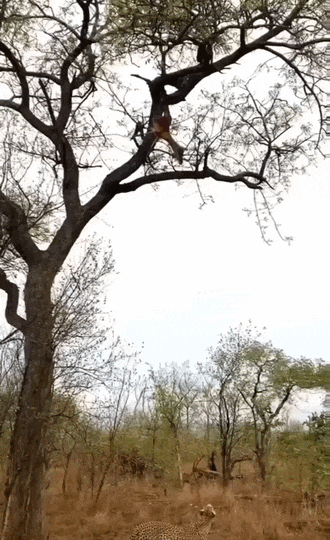
FROM : buckstootsie
37 notes
·
View notes
Text
So Minecraft has new wolves!!
I am very happy about this, but it does make me curious what species each variation is based off of! You too? Awesome!

Rusty Wolf = Dhole



Seeing a little red jungle wolf took me right back to reading The Jungle Book as a kid, so I pretty much instantly decided they were dholes! A.k.a. Asian wild dogs or red dogs. They're an endangered canid native to Central, South, East and Southeast Asia, and they live in large clans ranging from 12-40 members.
Pale (Original) Wolf & Black Wolf = Grey Wolves
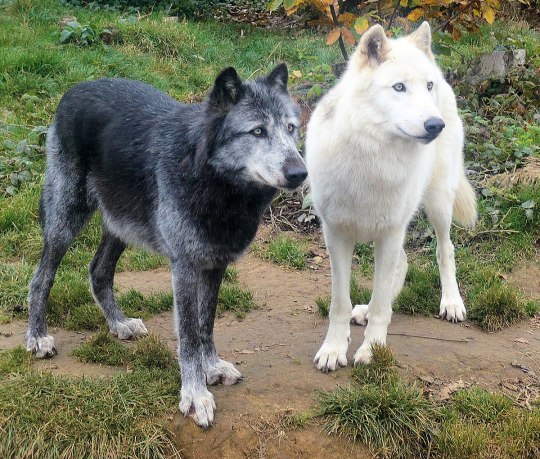
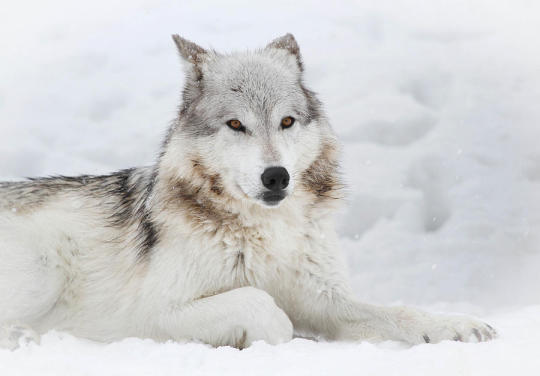
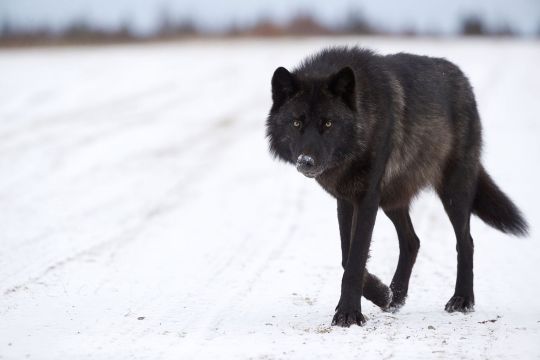
Our familiar friends have probably always been North American grey wolves, just pales ones! Despite their name, this iconic member of the canid family has an incredible amount of variation, and different subspecies of them are scattered all over North America.
Striped Wolf = Aardwolf
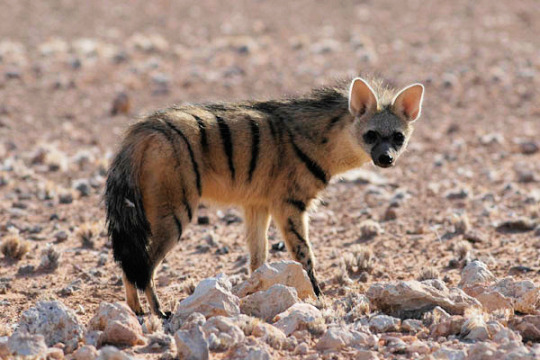
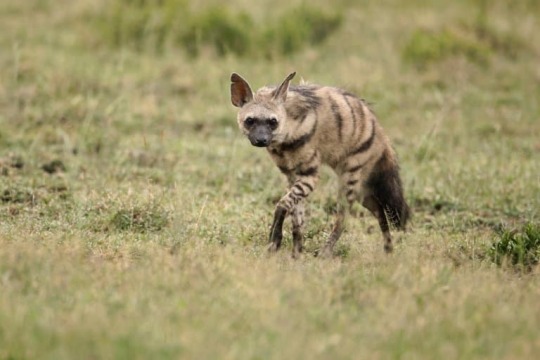
Okay, this is interesting, because they are definitely aardwolves! However, despite their names, aardwolves are actually the tiniest member of the hyaenidae family! Native to East and Southern Africa, they are exclusively insectivores and are known for following aardvarks to use their vacated burrows and foraging grounds. I think it's fascinating that a hyena was chosen for the wolf skins!
Snowy Wolf = Arctic Wolf

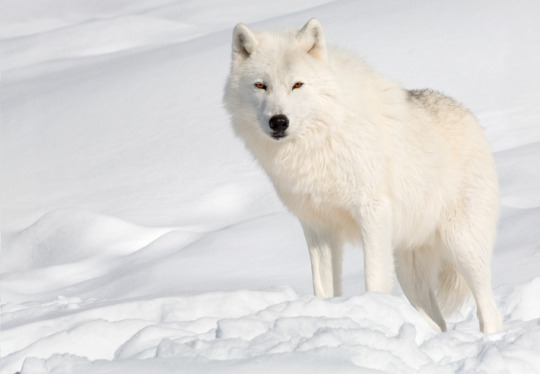
One of the many subspecies of gray wolves, arctic wolves are native to the Canadian Arctic and Alaska. Thanks to their territory being generally undesirable to humans, they are the only subspecies that can found across the entirety of their original range. Arctic wolves seem the most logical choice for snowy wolves, through there are several other pale-coated northern subspecies they could technically be.
Ashen Wolf = Northwestern Wolf


Speaking of northern subspecies, let's have some fun with the ashen variant. I'm pinning them as the Northwestern wolf, a.k.a. the Mackenzie Valley wolf! Native to, well, the northwestern part of Canada and Alaska, they are arguably the largest subspecies of wolf we know of. They match up pretty well with their Minecraft counterparts both in terms of habitat and possible coloration!
Woods Wolf = Eastern Wolf
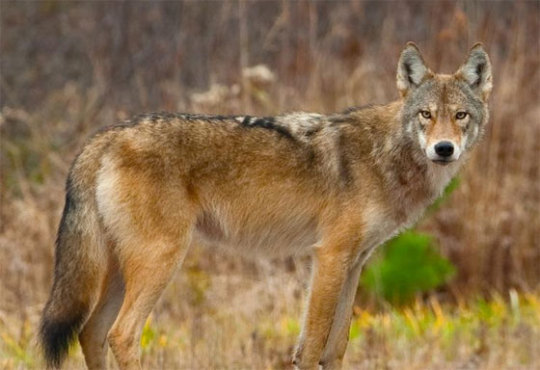
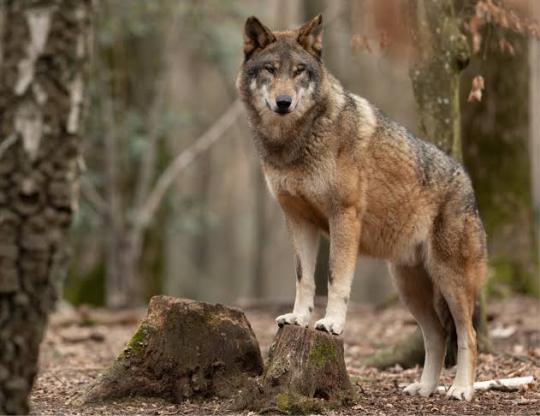
Ooo, okay, I went down a rabbit hole with this one! Eastern wolves, a.k.a Great Lakes wolves or Algonquin wolves, are native to the Great Lakes region of North America. They exist in an identification limbo, with no current ruling on whether they are a subspecies of grey wolf, red wolf, or their own unique branch that drifts closer to coyotes on the canid family tree. There is even some debate on whether the Great Lakes and Algonquin variants should be counted as the same subspecies, which I think is fascinating!
Spotted Wolf = African Wild Dog


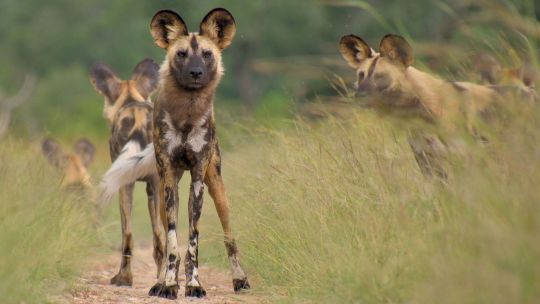
The more people who know these good bois exists, the happier I am. African wild dogs, a.k.a. painted dogs or Cape hunting dogs, are the largest wild canine in Africa. They live in packs of 5-30 members and are known their cooperative hunting tactics, using stamina to wear down prey. They're highly social animals, and you'll never find a lone dog.
Chestnut Wolf = Bat Eared Fox
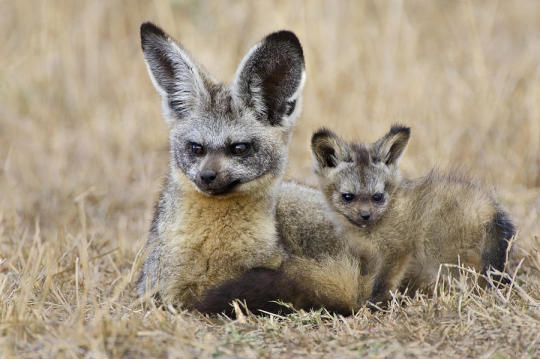
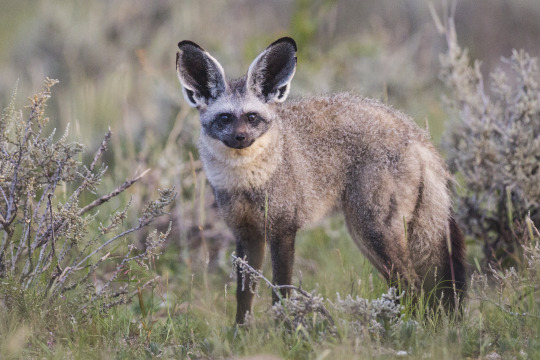
So, initially, I wrote off these guys cause I wasn't counting foxes, but I gave in. The chestnut wolves don't look like much of any existing canines, and nothing that lives in taiga forest. So, bat eared foxes are my best guess. They're small canids native to southern Africa, and are part of the subfamily Otocyoninae, which is a sister family to the families containing true foxes and racoon dogs.

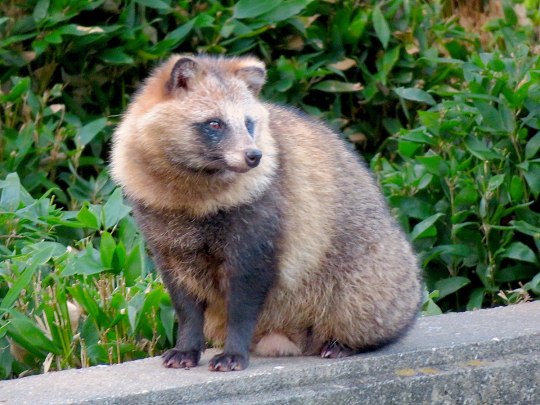
Speaking of raccoon dogs, they're my second best guess for the origin of the chestnut wolf. Their habitat makes slightly more sense, being from the forests of Japan and east Asia!
#i finally get to infodump on cool animals#also i learned A LOT researching for this!#minecraft#minecraft wolf#sharp has too many thoughts
20 notes
·
View notes
Text

Appendix V: Checks to Over-Multiplication
Hudson, in his Naturalist on the La Plata (Chapter III), has a very interesting account of a sudden increase of a species of mice and of the consequences of that sudden “wave of life.” “In the summer of 1872–73,” he writes, “we had plenty of sunshine, with frequent showers, so that the hot months brought no dearth of wild flowers, as in most years.” The season was very favourable for mice, and “these prolific little creatures were soon so abundant that the dogs and the cats subsisted almost exclusively on them. Foxes, weasels and opossums fared sumptuously; even the insectivorous armadillo took to mice-hunting.” The fowls became quite rapacious, “while the sulphur tyrant-birds (Pitangus) and the Guira cuckoos preyed on nothing but mice.” In the autumn, countless numbers of storks and of short-eared owls made their appearance, coming also to assist at the general feast. Next came a winter of continued drought; the dry grass was eaten, or turned to dust; and the mice, deprived of cover and food, began to die out. The cats sneaked back to the houses; the short-eared owls — a wandering species — left; while the little burrowing owls became so reduced as scarcely to be able to fly, “and hung about the houses all day long on the look-out for some stray morsel of food. “Incredible numbers of sheep and cattle perished the same winter, during a month of cold that followed the drought. As to the mice, Hudson makes the remark that “scarcely a hard-pressed remnant remains after the great reaction, to continue the species.”
This illustration has an additional interest in its showing how, on flat plains and plateaus, the sudden increase of a species immediately attracts enemies from other parts of the plains, and how species unprotected by their social organization must necessarily succumb before them.
Another excellent illustration in point is given by the same author from the Argentine Republic. The coypù (Myiopotamus coypù) is there a very common rodent — a rat in shape, but as large as an otter. It is aquatic in its habits and very sociable. “Of an evening,” Hudson writes, “they are all out swimming and playing in the water, conversing together in strange tunes, which sound like the moans and cries of wounded and suffering men. The coypù, which has a fine fur under the long coarse hair, was largely exported to Europe; but some sixty years ago the Dictator Rosas issued a decree prohibiting the hunting of this animal. The result was that the animals increased and multiplied exceedingly, and, abandoning their aquatic habits, they became terrestrial and migratory, and swarmed everywhere in search of food. Suddenly a mysterious malady fell on them, from which they quickly perished, and became almost extinct” (p. 12).
Extermination by man on the one side, and contagious diseases on the other side, are thus the main checks which keep the species down — not competition for the means of existence, which may not exist at all.
Facts, proving that regions enjoying a far more congenial climate than Siberia are equally underpopulated, could be produced in numbers. But in Bates’ well-known work we find the same remark concerning even the shores of the Amazon river.
“There is, in fact,” Bates wrote, “a great variety of mammals, birds and reptiles, but they are widely scattered and all excessively shy of man. The region is so extensive and uniform in the forest-clothing of its surface, that it is only at long intervals that animals are seen in abundance, where some particular spot is found which is more attractive than the others” (Naturalist on the Amazon, 6th ed., p. 31).
This fact is the more striking as the Brazilian fauna, which is poor in mammals, is not poor at all in birds, and the Brazilian forests afford ample food for birds, as may be seen from a quotation, already given on a previous page, about birds’ societies. And yet, the forests of Brazil, like those of Asia and Africa, are not overpopulated, but rather under-populated. The same is true concerning the pampas of South America, about which W.H. Hudson remarks that it is really astonishing that only one small ruminant should be found on this immense grassy area, so admirably suited to herbivorous quadrupeds. Millions of sheep, cattle and horses, introduced by man, graze now, as is known, upon a portion of these prairies. Land-birds on the pampas are also few in species and in numbers.
#organization#revolution#mutual aid#anarchism#daily posts#communism#anti capitalist#anti capitalism#late stage capitalism#anarchy#anarchists#libraries#leftism#social issues#economy#economics#climate change#anarchy works#environmentalism#environment#solarpunk#anti colonialism#a factor of evolution#petr kropotkin
13 notes
·
View notes
Text
Otocyon Megalotis
The bat eared fox, native to south and east Africa, isn’t really a fox. It is the only living species of an ancient genus of canines called otocyon, which essentially means “ear dog.” Ear dog is a fitting name for them, seeing as each ear is considerably larger than their entire head. These massive ears regulate their body temperature and allow them to listen for predators including hyenas, lions, jackals, and wild dogs, and their prey which consists almost entirely of insects. To escape their predators they have evolved to be extremely agile and are able to turn sharply at high speeds, outmaneuvering almost any animal. They can also climb quite well.

Bat eared foxes are nocturnal, so they spend the majority of the day sleeping in their burrows which are very large with many chambers, tunnels, and entrances. Some even make their burrows in termite mounds. In these burrows they live in small, social family groups. Once every year the females have 3-6 kits which the male looks after. The males are very good with the kits, watching over them constantly and oftentimes playing with them. Meanwhile, the females hunt for termites and other insects. It’s from these insects that the foxes (not really foxes tho) get almost all of their water- they very rarely actually drink.
When the kits are 5-6 months old they leave the parents to find their own territory and mate. Bat eared foxes are not very territorial and sometimes gather in groups to scavenge for food, and occasionally pairs of foxes will let other females join their family group.
I rate them 9/10. Very cute, but really strange-looking. Might be a hoax
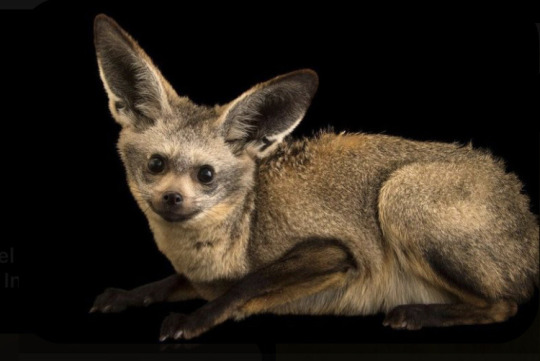

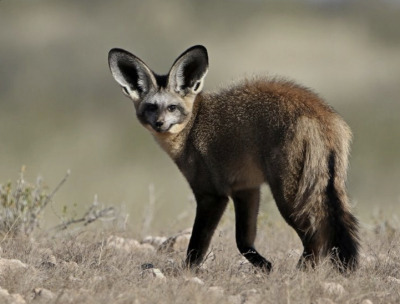
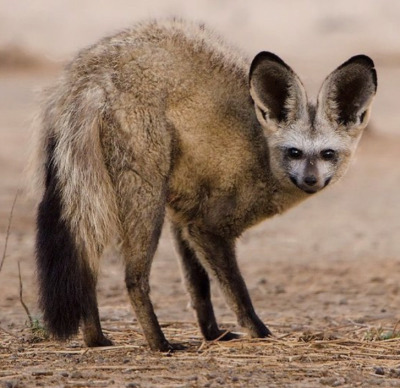
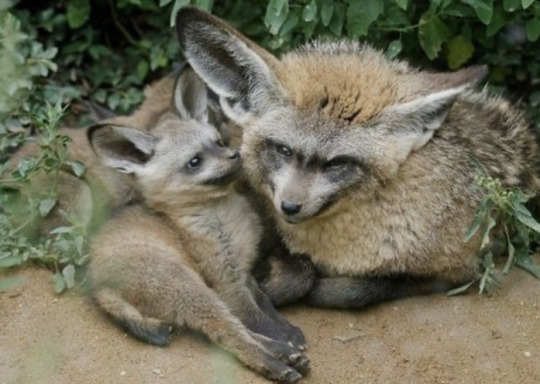
470 notes
·
View notes
Text
Animal of the Day!
Common Genet (Genetta genetta)
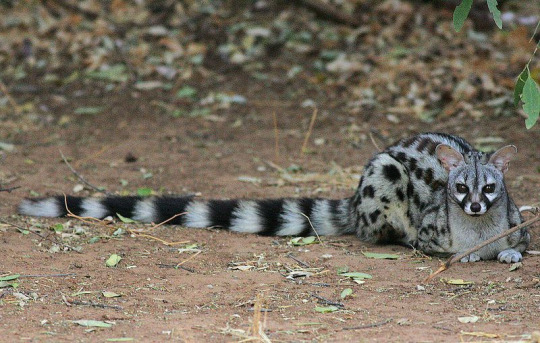
(Photo by Steve Garvie)
Conservation Status- Least Concern
Habitat- Northern Africa; Sub-Saharan Africa; Southern Africa
Size (Weight/Length)- 2 kg; 55 cm; 50 cm tail
Diet- Insects; Fruits; Small mammals; Birds; Bird eggs
Cool Facts- Related to the civets, common genets are highly adaptive omnivores. They are both nocturnal and solitary, sleeping their days away in tree tops. During the night, they change into hunting mode. Common genets eat almost anything that’s slow enough to catch, capable of racing across desert dunes and treetops alike. Common genets hold large territories, fiercely defending it from other genets and small predators. During the mating seasons, genet will hiccup at each other to communicate and signal a friendly interaction.
Rating- 12/10 (Biggest threat is the pet trade, wild animals should stay wild.)
Requested by @cosmiccake3
#Animal of the day#Animals#Mammals#Genet#Civet#Viverridae#Monday#January 16#Common genet#biology#science#conservation#the more you know#request#cosmiccake3
554 notes
·
View notes